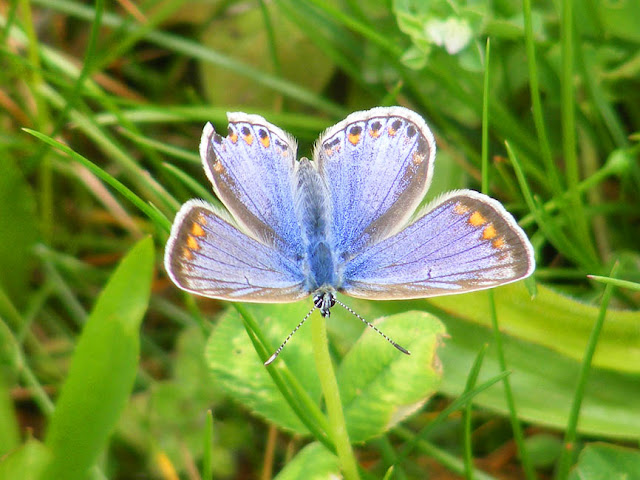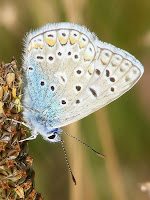Scientific Name: Polyommatus icarus. The specific name is a reference to the foolish youth who flew too close to the sun with artificial wings and fell from the bright blue sky into the sea.
English Name: Common Blue.
French Name: L'Argus bleu or l'Azuré de la bugrane.

5 Key Characters:
Habitat: Open landscapes of all kinds, heaths and open woodland. Adaptable and with caterpillars able to eat a variety of plant species, they have readily colonised manmade habitats such as garden lawns and flowerbeds, banks and tracks where Black Medick or White Clover grow.
Flight Period: March-April-May-June-July-August-September-October-November.
Status: A grassland indicator species in decline in much of Europe, but stable within the EU. Data collected on grassland indicator species is used to determine how well grassland habitat is doing. One of the top 10 most widely distributed, common and abundant species in France.
Caterpillar: Small and green with a fine yellow stripe down the side. June-April, overwintering as a caterpillar.
Host Plant: Numerous legumes (Fabaceae) - Common Birdsfoot Trefoil Lotus corniculatus, Greater Birdsfoot Trefoil L. pedunculatus, Bur Medick Medicago minima, Lucerne M. sativa, Black Medick M. lupulina, Barrel Medick M. truncatula, Red Clover Trifolium pratense, White Clover T. repens, Prostrate Canary Clover Dorycnium pentaphyllum, Hairy Canary Clover D. hirsutum, the Sainfoin Onobrychis supina, Montpellier Milk Vetch Astragalus monspessulanus, Spanish Gorse Genista hispanica, Hairy Greenweed G. pilosa, Dwarf Gorse Ulex parviflorus.
Photographed by Loire Valley Nature:
Photographs numbered from left to right and top to bottom. 1-2 Male, April. 3 Unusually blue female, P. icarus f. caerulea. 4 & 8 male in damp pasture in the Brenne, May. 5 - 7 male in our orchard, May. 9 & 13 male on Ribwort Plantain Plantago lanceolata seedhead in our orchard, May. 10 - 12 & 14 - 18 two slightly confused males tentatively attending a similarly responsive Brown Argus Aricia agestis female on Common Birdsfoot Trefoil Lotus corniculatus in our orchard, May.


















English Name: Common Blue.
French Name: L'Argus bleu or l'Azuré de la bugrane.

5 Key Characters:
- upperside of male blue, female brown washed with blue.
- reddish orange crescents around the border of fore and rear wings on the upperside of the female.
- wings fringed with white.
- background colour of underside varies according to the season (greyer in spring and autumn, browner in summer).
- the upperside of the females in summer often do not have the blue suffusion at the base of the wings.
Habitat: Open landscapes of all kinds, heaths and open woodland. Adaptable and with caterpillars able to eat a variety of plant species, they have readily colonised manmade habitats such as garden lawns and flowerbeds, banks and tracks where Black Medick or White Clover grow.
Flight Period: March-April-May-June-July-August-September-October-November.
Status: A grassland indicator species in decline in much of Europe, but stable within the EU. Data collected on grassland indicator species is used to determine how well grassland habitat is doing. One of the top 10 most widely distributed, common and abundant species in France.
Caterpillar: Small and green with a fine yellow stripe down the side. June-April, overwintering as a caterpillar.
Host Plant: Numerous legumes (Fabaceae) - Common Birdsfoot Trefoil Lotus corniculatus, Greater Birdsfoot Trefoil L. pedunculatus, Bur Medick Medicago minima, Lucerne M. sativa, Black Medick M. lupulina, Barrel Medick M. truncatula, Red Clover Trifolium pratense, White Clover T. repens, Prostrate Canary Clover Dorycnium pentaphyllum, Hairy Canary Clover D. hirsutum, the Sainfoin Onobrychis supina, Montpellier Milk Vetch Astragalus monspessulanus, Spanish Gorse Genista hispanica, Hairy Greenweed G. pilosa, Dwarf Gorse Ulex parviflorus.
Photographed by Loire Valley Nature:
Photographs numbered from left to right and top to bottom. 1-2 Male, April. 3 Unusually blue female, P. icarus f. caerulea. 4 & 8 male in damp pasture in the Brenne, May. 5 - 7 male in our orchard, May. 9 & 13 male on Ribwort Plantain Plantago lanceolata seedhead in our orchard, May. 10 - 12 & 14 - 18 two slightly confused males tentatively attending a similarly responsive Brown Argus Aricia agestis female on Common Birdsfoot Trefoil Lotus corniculatus in our orchard, May.


















 |
| Very worn, photographed in our orchard, Preuilly sur Claise, June. |
 |
| Very worn, photographed in our orchard, Preuilly sur Claise, June. |
 |
| Nectaring on Wild Oregano Origanum vulgaris. |
 |
| Male on Common Birdsfoot Trefoil Lotus corniculatus. |
 |
| Male on Black Medick Medicago lupulina |
 |
| Male. |
 |
| Male. |
 |
| Male. |






No comments:
Post a Comment